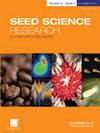桃科种子(真种子加内果皮)休眠与家族下分类和内果皮解剖的关系
IF 1.9
3区 生物学
Q2 PLANT SCIENCES
引用次数: 2
摘要
摘要利用文献中的信息和作者未发表的关于Dobinea的结果,确定了Anacardiaceae所有五个部落的种子(真种子+内果皮)休眠和非休眠的种类[类别],并将结果与科内的分类位置和内果皮解剖相关。对Spondiadeae族15属、Anacardiae族6属、Rhoeae族30属、Semecarpeae族3属和Dobineae族1属的种子发芽和内果皮解剖进行了研究。在Spondiadeae(Spondias型内果皮)、Anacardiae、Semekepeae和Dobineae(Anacardiam型外果皮)中,种子要么处于非休眠状态(ND),要么处于生理休眠状态(PD)。另一方面,在Rheae(Anacardium型Rheae A、B、C和D组内果皮)中,种子为ND或具有物理休眠(PY)、PD或PY+PD。该部落的PY/PY+PD似乎仅限于(或几乎如此)Rhus s.s和具有Anacardium类型Rheae A类内果皮的密切相关属(如Cotinus、Malosma和Toxicodendron)。然而,具有这种内果皮的其他属(如Astronium和Schinus)的种子以及具有Rheae B组(如Pistacia)、C组(如Pentapadon)和D组(如Heeria)内果皮的种子要么是ND,要么是PD。果实化石记录强烈表明,Anacardiaceae的内果皮结构和分类位置至少可以追溯到古近纪。本文章由计算机程序翻译,如有差异,请以英文原文为准。
Seed (true seed plus endocarp) dormancy in Anacardiaceae in relation to infrafamilial taxonomy and endocarp anatomy
Abstract Information in the literature and unpublished results of the authors on Dobinea were used to determine the kind [class(es)] of seed (true seed + endocarp) dormancy and of non-dormancy of genera in all five tribes of Anacardiaceae, and the results were examined in relation to the taxonomic position and endocarp anatomy within the family. Reports of both seed germination and endocarp anatomy were found for 15 genera in tribe Spondiadeae, 6 in tribe Anacardieae, 30 in tribe Rhoeae, 3 in tribe Semecarpeae and 1 in tribe Dobineeae. In Spondiadeae (Spondias-type endocarp), Anacardieae, Semecarpeae and Dobineeae (Anacardium-type endocarp), seeds are either non-dormant (ND) or have physiological dormancy (PD). In Rhoeae (Anacardium-type Rhoeae Groups A, B, C and D endocarps), on the other hand, seeds are ND or have physical dormancy (PY), PD or PY + PD. PY/PY + PD in this tribe seems to be restricted (or nearly so) to Rhus s.s. and closely related genera (e.g. Cotinus, Malosma and Toxicodendron) with an Anacardium-type Rhoeae Group A endocarp. However, seeds of other genera (e.g. Astronium and Schinus) with this type of endocarp and those with Rhoeae Group B (e.g. Pistacia), Group C (e.g. Pentaspadon) and Group D (e.g. Heeria) endocarps are either ND or have PD. The fossil fruit record strongly suggests that present-day relationships between diaspore dormancy (or non-dormancy), endocarp structure and taxonomic position within Anacardiaceae extend back to at least the Palaeogene.
求助全文
通过发布文献求助,成功后即可免费获取论文全文。
去求助
来源期刊

Seed Science Research
生物-植物科学
CiteScore
3.60
自引率
4.80%
发文量
23
审稿时长
>12 weeks
期刊介绍:
Seed Science Research, the official journal of the International Society for Seed Science, is a leading international journal featuring high-quality original papers and review articles on the fundamental aspects of seed science, reviewed by internationally distinguished editors. The emphasis is on the physiology, biochemistry, molecular biology and ecology of seeds.
 求助内容:
求助内容: 应助结果提醒方式:
应助结果提醒方式:


